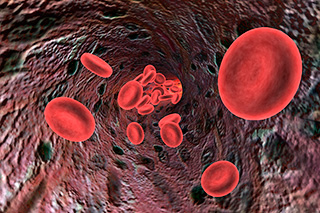Despite the lack of randomized clinical studies, hemoglobin transfusions are widely believed to mitigate tumor hypoxia-associated radiotherapy resistance, a significant clinical challenge for a subset of patients with cervical cancer. A new consensus guideline suggests that until well-designed clinical trials identify a specific transfusion level hemoglobin threshold or goal, packed red blood cell transfusions of at least 9 g/dL and less than 12 g/dL should be undertaken for patients undergoing radiotherapy for cervical cancer.1 More research is needed. Researchers are exploring the roles of biomarkers, medical imaging, and radiosensitization agents in overcoming the challenge of hypoxia-associated tumor radioresistance.
Some patients undergoing radiotherapy for cervical cancer, particularly when receiving concurrent cisplatin chemotherapy, experience anemia and poor local tumor control rates associated with tumor hypoxia, defined as the development of hypoxia in poorly vascularized regions of malignancies, where cancer cells can rapidly evolve hypoxia tolerance.1 Anemia can accelerate tumor evolution to hypoxic-tolerant states.
Understanding Tumor Hypoxia
Tumors can contain nonhypoxic and hypoxic regions, and these regions can change over time, complicating research. For reasons that are not yet well understood, tumor hypoxia is associated with tumor treatment resistance, including radioresistance, and poor patient prognosis.1,2 One possible factor is believed to be that low-oxygen tumor regions are subjected to lower levels of radiotherapy-unleashed DNA-damaging free radicals.1
Specific gene pathways appear to play a role in epigenetic changes in hypoxic tumors.1,3,4 Because tumor hypoxia triggers tumor recruitment of new vasculature (neo-angiogenesis) and other changes in tumor biology, hypoxia and associated gene pathways are potentially important targets for clinical research.2 Determining the roles of specific gene variants and proteins in hypoxic tumor metabolism, for example, might yield targets for molecular therapies or the development of tumor hypoxia biomarkers.2,4,5 Very preliminary preclinical research with cell lines suggests that rapamycin might possibly inhibit hypoxic cervical cancer cell proliferation.6
Magnetic resonance imaging (MRI) and computed tomography (CT) imaging are keystones of cervical cancer tumor size measurement, cancer staging, and target volume delineation in radiotherapy planning.2 Fluorine 18-fluorodeoxyglucose (18F-FDG) positron emission tomography (PET)/CT imaging is sometimes used to stage lymph node involvement when metastatic cervical cancer is suspected.2
Whether 18F-FDG PET can reliably detect hypoxic tumors is unclear because both hypoxic and nonhypoxic regions of cervical tumors consume high levels of glucose for different reasons, which translates to strong 18F-FDG PET signal intensity.2
Other imaging techniques for detecting tumor hypoxia, including PET nitroimidazoles and Cu-ATSM radiotracer imaging and blood oxygenation MRI quantification, are under development that might improve prognostication and treatment decision making and aid the development of hypoxic tumor-targeting molecular therapies.2,4,5,7 To date, at least 9 molecular mechanisms have been tied to tumor hypoxia-associated radioresistance, including altered cellular signaling pathways, heat shock protein production, angiogenesis, energy metabolism, and epigenetic regulation.7
Each of these represent potential molecular targets for new treatments. However, clinical research is slow and the need for treatments that can overcome hypoxia-associated radioresistance is urgent.
Exploring the Potential of RBC Transfusion
One available treatment is hemoglobin (packed red blood cell [PRBC]) transfusion. Transfusion can treat anemia, which is associated with hypoxia-associated radiosensitization.1
There have not yet been randomized clinical studies of the tumor control and patient survival benefits of PRBC transfusions before radiotherapy, but retrospective studies suggest they can be useful in mitigating hypoxia-induced tumor radioresistance in patients with cervical cancer.1
Unfortunately, because of the immature evidence base, there is no broad agreement on the optimal, specific threshold level of PRBC transfusion. A recent consensus study of international experts showed most (31 of 35) support a transfusion target of at least 9 g/dL and less than 12 g/dL PRBC for patients with cervical cancer undergoing external beam radiotherapy and brachytherapy.1 The study was the first such international expert consensus guidance.
“A minimum hemoglobin transfusion target of 9 g/dL was endorsed to balance tumor radiosensitivity with appropriate use of a scarce resource,” reported David P. D’Souza, MD, of the London Health Sciences Centre in London, Ontario, Canada, and coauthors.1
“Although a hemoglobin level between at least 9 g/dL and less than 12 g/dL was endorsed as the consensus transfusion target, significant variability in clinical practice persists owing to the lack of high-level evidence,” the authors cautioned, calling for randomized clinical trials to identify an optimal specific transfusion target.1
References
1. Zayed S, Nguyen TK, Lin C, et al. Red blood cell transfusion practices for patients with cervical cancer undergoing radiotherapy. JAMA Network Open. 2021;4(4):e213531. doi:10.1001/jamanetworkopen.2021.3531
2. Lyng H, Malinen E. Hypoxia in cervical cancer: from biology to imaging. Clin Transl Imaging. 2017;5:373-388. doi:10.1007/s40336-017-0238-7
3. Chang S, Yim S, Park H. The cancer driver genes IDH1/2, JARID1C/KDM5C, and UTX/KDM6A: crosstalk between histone demethylation and hypoxic reprogramming in cancer metabolism. Experim Molec Med. 2019;51:1-17. doi:10.1038/s12276-019-0230-6
4. Khouzam RA, Brodaczewska K, Filipiak A, et al. Tumor hypoxia regulates immune escape/invasion: influence on angiogenesis and potential impact of hypoxic biomarkers on cancer therapies. Frontiers Immunol. 2021;11:613114. doi:10.3389/fimmu.2020.613114
5. Waller J, Onderdonk B, Flood A, et al. The clinical utility of imaging methods used to measure hypoxia in cervical cancer. Br J Radiol. 2020;93(1111):20190640. doi:10.1259/bjr.20190640
6. Rezazadeh D, Norooznezhad AH, Mansouri K, et al. Rapamycin reduces cervical cancer cells viability in hypoxic condition: investigation of the role of autophagy and apoptosis. Onco Targets Ther. 2020;13:4239-4247. doi:10.2147/OTT.S249985
7. Kabakov AE, Yakimova AO. Hypoxia-induced cancer cell responses driving radioresistance of hypoxic tumors: approaches to targeting and radiosensitizing. Cancers (Basel). 2021;13(5):1102. doi:10.3390/cancers13051102
